TRIMIS: Modular Development of an Integrated Policy-Support Tool for Forward-Oriented Transport Research and Innovation Analysis
Abstract
1. Introduction
- Connected and automated transport (CAT);
- Transport electrification (ELT);
- Vehicle design and manufacturing (VDM);
- Low-emission alternative energy for transport (ALT);
- Network and traffic management systems (NTM);
- Smart mobility and services (SMO); and
- Transport infrastructure (INF).
2. Background and Motivation
3. TRIMIS Structure and Methods
3.1. Innovation Capacity Assessment
3.2. Technologies Inventory
3.3. Patent and Scientific Research Analysis
- Attributing a CPC code directly (if the technology directly fits within a single category);
- Assigning a set of keywords to each technology to carry out a keyword search on titles and abstracts; and
- Setting a year for the earliest filing date (2013 is the earliest available starting year from the patent database).
3.4. Horizon Scanning
4. Case Study
4.1. Technologies in European Framework Programs for Research and Innovation
4.2. TRIMIS Horizon Scanning Outputs
- Radical solutions to replace cars in urban environments;
- Fleet modernization through retrofitting;
- Electrification and escalation of power demand; and
- Automation to maintain the current system with fewer externalities.
5. Discussion and Conclusions
Author Contributions
Funding
Acknowledgments
Conflicts of Interest
Glossary
| ACARE | Advisory Council for Aviation Research and Innovation in Europe |
| ALICE | Alliance for Logistics Innovation through Collaboration in Europe |
| ALT | Low-emission Alternative Energy for Transport |
| BERD | Business expenditure on Research and Development |
| CAT | Connected and Automated Transport |
| CCAM | Cooperative, Connected and Automated Mobility |
| CL | Horizon Scanning Cluster |
| CO2 | Carbon dioxide |
| CORDIS | Community Research and Development Information Service |
| CPC | Cooperative Patent Classification |
| DG MOVE | European Commission Directorate-General for Mobility and Transport |
| DG RTD | European Commission Directorate-General for Research and Innovation |
| EC | European Commission |
| ELT | Transport electrification |
| EPO | European Patent Office |
| ERRAC | European Rail Research Advisory Council |
| ERTRAC | European Road Transport Research Advisory Council |
| EU | European Union |
| EUR | Euro |
| EV | Electric vehicle |
| GBAORD | Government Budget Appropriations or Outlays for Research and Development |
| GDP | Gross domestic product |
| GHG | Greenhouse gases |
| GVA | Gross value added |
| I | Horizon Scanning Item |
| ICT | Information and communications technology |
| JRC | Joint Research Centre |
| INF | Transport infrastructure |
| IoT | Internet of Things |
| IRI | Industrial Research and Innovation |
| KPI | Key performance indicator |
| MaaS | Mobility as a Service |
| MC | Horizon Scanning meta-cluster |
| NASA | National Aeronautics and Space Administration |
| NETT | New and emerging technologies and trends |
| NO2 | Nitrogen dioxide |
| NTM | Network and traffic management systems |
| O3 | Ozone |
| OBS | Horizon Scanning observation |
| OECD | Organization for Economic Co-operation and Development |
| PATSTAT | EPO Worldwide Patent Statistical Database |
| PCT | Patent Cooperation Treaty |
| PM2.5 | Particulate matter |
| REGEX | Regular expressions |
| R & D | Research and Development |
| R & I | Research and Innovation |
| RIO | Research and Innovation Observatory |
| SDG | Sustainable Development Goal |
| SET | Strategic Energy Technology |
| SETIS | Strategic Energy Technologies Information System |
| SMO | Smart mobility and services |
| STRIA | Strategic Transport Research and Innovation Agenda |
| TIM | Tools for innovation monitoring |
| TRB | Transportation Research Board |
| TRID | Transport Research International Documentation |
| TRIMIS | Transport Research and Innovation Monitoring and Information System |
| TRL | Technology readiness level |
| UN | United Nations |
| VDM | Vehicle design and manufacturing |
| WIPO | World Intellectual Property Office |
References
- United Nations Make Cities and Human Settlements Inclusive, Safe, Resilient and Sustainable. Available online: https://sdgs.un.org/goals/goal11 (accessed on 29 October 2020).
- Beškovnik, B.; Golnar, M. Eliminating Barriers for Sustainable Transport Systems on Maritime Silk Road and Baltic-Adriatic Corridor under BRI. Sustainability 2020, 12, 7412. [Google Scholar] [CrossRef]
- European Commission. Statistical Pocketbook 2019. Available online: https://ec.europa.eu/transport/facts-fundings/statistics/pocketbook-2019_en (accessed on 29 September 2019).
- Eurostat Final Energy Consumption by Sector. Available online: https://ec.europa.eu/eurostat/web/products-datasets/-/ten00124 (accessed on 14 April 2020).
- European Environment Agency Sectoral Greenhouse Gas Emissions by IPCC Sector. Available online: https://www.eea.europa.eu/data-and-maps/daviz/change-of-co2-eq-emissions-2/#parent-fieldname-title (accessed on 11 November 2020).
- European Environment Agency. Annual European Union Greenhouse Gas Inventory 1990–2015 and Inventory Report 2017; European Environment Agency: Copenhagen, Denmark, 2017. [Google Scholar]
- European Environment Agency. Air Quality in Europe—2016 Report; Publications Office of the European Union: Luxembourg, 2016; ISBN 978-92-9213-847-9. [Google Scholar] [CrossRef]
- European Commission. Europe on the Move-An Agenda for a Socially Fair Transition towards Clean, Competitive and Connected Mobility for All COM/2017/0283 Final; European Commission: Brussels, Belgium, 2017. [Google Scholar]
- European Commission. White Paper Roadmap to a Single European Transport. Area–Towards a Competitive and Resource Efficient Transport System COM/2011/0144 Final; European Commission: Brussels, Belgium, 2011. [Google Scholar]
- European Commission. The European Green Deal COM/2019/640 Final; European Commission: Brussels, Belgium, 2019. [Google Scholar]
- European Commission. Communication from the Commission to the European Parliament, the Council, the European Economic and Social Committee and the Committee of the Regions Stepping up Europe’s 2030 Climate Ambition Investing in a Climate-Neutral Future for the Benefit of Our; European Commission: Brussels, Belgium, 2020. [Google Scholar]
- European Commission. Energy Union Package-A Framework Strategy for a Resilient Energy Union with a Forward-Looking Climate Change Policy COM/2015/080 Final; European Commission: Brussels, Belgium, 2015. [Google Scholar]
- European Commission. A European Strategy for Low-Emission Mobility COM/2016/0501 Final; European Commission: Brussels, Belgium, 2016. [Google Scholar]
- European Commission. Accelerating Clean Energy Innovation COM/2016/0763 Final; European Commission: Brussels, Belgium, 2016. [Google Scholar]
- European Commission. Towards Clean, Competitive and Connected Mobility: The Contribution of Transport Research and Innovation to the Mobility Package SWD/2017/0223 Final; European Commission: Brussels, Belgium, 2017. [Google Scholar]
- European Commission. Towards an Integrated Strategic Energy Technology (SET) Plan: Accelerating the European Energy System Transformation C/2015/6317 Final; European Commission: Brussels, Belgium, 2015. [Google Scholar]
- European Commission. TRIMIS Transport and Research and Innovation Monitoring and Information System. Available online: https://trimis.ec.europa.eu/ (accessed on 11 November 2020).
- Arbib, J.; Seba, T. Rethinking Transportation 2020–2030: The Disruption of Transportation and the Collapse of the Internal-Combustion Vehicle and Oil Industries, 1st ed.; RethinkX: San Francisco, CA, USA, 2017; ISBN 978-0-9994016-0-6. [Google Scholar]
- Goyal, N.; Howlett, M. Technology and Instrument Constituencies as Agents of Innovation: Sustainability Transitions and the Governance of Urban Transport. Energies 2018, 11, 1198. [Google Scholar] [CrossRef]
- Nosal Hoy, K.; Solecka, K.; Szarata, A. The Application of the Multiple Criteria Decision Aid to Assess Transport Policy Measures Focusing on Innovation. Sustainability 2019, 11, 1472. [Google Scholar] [CrossRef]
- Auvinen, H.; Tuominen, A. Future Transport Systems: Long-Term Visions and Socio-Technical Transitions. Eur. Transp. Res. Rev. 2014, 6, 343–354. [Google Scholar] [CrossRef]
- Cledou, G.; Estevez, E.; Soares Barbosa, L. A Taxonomy for Planning and Designing Smart Mobility Services. Gov. Inf. Q. 2018, 35, 61–76. [Google Scholar] [CrossRef]
- Hyard, A. Non-Technological Innovations for Sustainable Transport. Technol. Forecast. Soc. Chang. 2013, 80, 1375–1386. [Google Scholar] [CrossRef]
- Markvica, K.; Hu, B.; Prandtstetter, M.; Ritzinger, U.; Zajicek, J.; Berkowitsch, C.; Hauger, G.; Pfoser, S.; Berger, T.; Eitler, S.; et al. On the Development of a Sustainable and Fit-for-the-Future Transportation Network. Infrastructures 2018, 3, 1–10. [Google Scholar] [CrossRef]
- Wang, Y.; Gu, J.; Wang, S.; Wang, J. Understanding Consumers’ Willingness to Use Ride-Sharing Services: The Roles of Perceived Value and Perceived Risk. Transp. Res. Part C Emerg. Technol. 2019, 105, 504–519. [Google Scholar] [CrossRef]
- Vilchez, J.J.G.; Smyth, A.; Kelleher, L.; Lu, H.; Rohr, C.; Harrison, G.; Thiel, C. Electric Car Purchase Price as a Factor Determining Consumers’ Choice and Their Views on Incentives in Europe. Sustainability 2019, 11, 1–14. [Google Scholar] [CrossRef]
- Khan, R.; Tausif, S.; Javed Malik, A. Consumer Acceptance of Delivery Drones in Urban Areas. Int. J. Consum. Stud. 2019, 43, 87–101. [Google Scholar] [CrossRef]
- Nieuwenhuijsen, J.; de Almeida Correia, G.H.; Milakis, D.; van Arem, B.; van Daalen, E. Towards a Quantitative Method to Analyze the Long-Term Innovation Diffusion of Automated Vehicles Technology Using System Dynamics. Transp. Res. Part C Emerg. Technol. 2018, 86, 300–327. [Google Scholar] [CrossRef]
- Guo, J.; Susilo, Y.; Antoniou, C.; Pernestål Brenden, A. Influence of Individual Perceptions on the Decision to Adopt Automated Bus Services. Sustainability 2020, 12, 6484. [Google Scholar] [CrossRef]
- Ploetner, K.O.; Al Haddad, C.; Antoniou, C.; Frank, F.; Fu, M.; Kabel, S.; Llorca, C.; Moeckel, R.; Moreno, A.T.; Pukhova, A.; et al. Long-Term Application Potential of Urban Air Mobility Complementing Public Transport: An Upper Bavaria Example. CEAS Aeronaut. J. 2020, 11, 991–1007. [Google Scholar] [CrossRef]
- Wiesenthal, T.; Condeço-Melhorado, A.; Leduc, G. Innovation in the European transport sector: A review. Transport. Policy 2015, 42, 86–93. [Google Scholar] [CrossRef]
- Jung, S.; Kwak, G. Firm Characteristics, Uncertainty and Research and Development (R & D) Investment: The Role of Size and Innovation Capacity. Sustainability 2018, 10, 1668. [Google Scholar] [CrossRef]
- Weber, K.M.; Kubeczko, K.; Kaufmann, A.; Grunewald, B. Trade-Offs between Policy Impacts of Future-Oriented Analysis: Experiences from the Innovation Policy Foresight and Strategy Process of the City of Vienna. Technol. Anal. Strateg. Manag. 2009, 21, 953–969. [Google Scholar] [CrossRef]
- European Commission. 2020 Strategic Foresight Report Strategic Foresight–Charting the Course towards a More Resilient Europe COM/2020/493 Final; European Commission: Brussels, Belgium, 2020. [Google Scholar]
- Garnett, K.; Lickorish, F.A.; Rocks, S.A.; Prpich, G.; Rathe, A.A.; Pollard, S.J.T. Integrating Horizon Scanning and Strategic Risk Prioritisation Using a Weight of Evidence Framework to Inform Policy Decisions. Sci. Total Environ. 2016, 560–561, 82–91. [Google Scholar] [CrossRef]
- Voros, J. A Generic Foresight Process Framework. Foresight 2003, 5, 10–21. [Google Scholar] [CrossRef]
- Loveridge, D. Foresight: The Art and Science of Anticipating the Future; Routledge: New York, NY, USA; London, UK, 2008; ISBN 978-0-415-39814-5. [Google Scholar]
- Amanatidou, E.; Butter, M.; Carabias, V.; Konnola, T.; Leis, M.; Saritas, O.; Schaper-Rinkel, P.; van Rij, V. On Concepts and Methods in Horizon Scanning: Lessons from Initiating Policy Dialogues on Emerging Issues. Sci. Public Policy 2012, 39, 208–221. [Google Scholar] [CrossRef]
- Tsakalidis, A.; Gkoumas, K.; Pekar, F.; Grosso, M.; Haq, G.; Marelli, L. Towards an Integrated European Platform for Monitoring and Analysing Transport Research and Innovation (TRIMIS). In Proceedings of the 7th Transport Research Arena TRA 2018, Vienna, Austria, 16–19 April 2018. [Google Scholar] [CrossRef]
- European Commission. Economics of Industrial Research and Innovation. Available online: https://iri.jrc.ec.europa.eu/home/ (accessed on 2 December 2020).
- European Commission. Research and Innovation Observatory–Horizon 2020 Policy Support Facility. Available online: https://rio.jrc.ec.europa.eu/ (accessed on 11 November 2020).
- European Commission. TIM-Tools for Innovation Monitoring. Available online: http://www.timanalytics.eu (accessed on 11 November 2020).
- European Commission. European Innovation Scoreboard. Available online: http://ec.europa.eu/growth/industry/innovation/facts-figures/scoreboards_en (accessed on 11 November 2020).
- European Commission. EU transport Scoreboard. Available online: https://ec.europa.eu/transport/facts-fundings/scoreboard_en (accessed on 11 November 2020).
- European Commission. SETIS Strategic Energy Technologies Information System. Available online: https://setis.ec.europa.eu/ (accessed on 11 November 2020).
- European Commission. European Technology Platforms. Available online: http://ec.europa.eu/research/innovation-union/index_en.cfm?pg=etp (accessed on 11 November 2020).
- National Academy of Sciences Transport Research International Documentation-TRID. Available online: https://trid.trb.org (accessed on 11 November 2020).
- OECD. OECD Science, Technology and Innovation Outlook 2016; OECD Publishing: Paris, France, 2016; ISBN 978-92-64-26305-5. [Google Scholar] [CrossRef]
- Tsakalidis, A.; van Balen, M.; Gkoumas, K.; Pekar, F. Catalyzing Sustainable Transport Innovation through Policy Support and Monitoring: The Case of TRIMIS and the European Green Deal. Sustainability 2020, 12, 3171. [Google Scholar] [CrossRef]
- van Balen, M.; Ortega Hortelano, A.; Grosso, M.; Tsakalidis, A.; Gkoumas, K.; Haq, G.; Pekar, F. EU Transport. Research & Innovation Status Assessment Report: An Overview Based on the Transport Research and Innovation Monitoring and Information System (TRIMIS) Database; Publications Office of the European Union: Luxembourg, 2019; ISBN 978-92-76-09005-2. [Google Scholar] [CrossRef]
- Grosso, M.; Ortega Hortelano, A.; Marques dos Santos, F.; Tsakalidis, A.; Gkoumas, K.; Pekar, F. Innovation Capacity in the Transport Sector: A European Outlook. An Assessment Based on the Transport Research and Innovation Monitoring and Information System (TRIMIS); Publications Office of the European Union: Luxembourg, 2020; ISBN 978-92-76-21045-0. [Google Scholar] [CrossRef]
- Grosso, M.; van Balen, M.; Ortega Hortelano, A.; Haq, G.; Gkoumas, K.; Tsakalidis, A.; Pekár, F. Innovation Capacity of the European Transport. Sector, A Macro-Level Analysis; Publications Office of the European Union: Luxembourg, 2019; ISBN 978-92-76-03655-5. [Google Scholar] [CrossRef]
- Glaser, B.G.; Strauss, A.L. The Discovery of Grounded Theory: Strategies for Qualitative Research; Aldine de Gruyter: New York, NY, USA, 1967; ISBN 978-0-20-230260-7. [Google Scholar]
- Gkoumas, K.; Tsakalidis, A. A Framework for the Taxonomy and Assessment of New and Emerging Transport Technologies and Trends. Transport 2019, 34, 455–466. [Google Scholar] [CrossRef]
- Gkoumas, K.; Marques dos Santos, F.; Tsakalidis, A.; van Balen, M.; Ortega Hortelano, A.; Grosso, M.; Pekár, F. New and Emerging Transport. Technologies and Trends in European Research and Innovation Projects—An Assessment Based on the Transport. Research and Innovation Monitoring and Information System (TRIMIS); Publications Office of the European Union: Luxembourg, Luxembourg, 2020; ISBN 978-92-76-21533-2. [Google Scholar] [CrossRef]
- INTEND Home-Intend Project. Available online: https://intend-project.eu (accessed on 26 February 2019).
- CPC Cooperative Patent Classification. Available online: https://www.cooperativepatentclassification.org (accessed on 26 February 2019).
- Héder, M. From NASA to EU: The Evolution of the TRL Scale in Public Sector Innovation. Innov. J. 2017, 22, 1–23. [Google Scholar]
- European Commission. Commission Decision C (2014) 4995, Horizon 2020–Work Programme 2014–2015, Annex G: Technology Readiness Levels (TRL); European Commission: Brussels, Belgium, 2014. [Google Scholar]
- Georgakaki, A.; Jimenez Navarro, J.P.; Pasimeni, F.; Fiorini, A.; Marmier, A.; Asensio, M. Socio-Economic Regional Microscope Series-Regional Performance in the Research, Innovation and Competitiveness Priorities of the Energy Union; Publications Office of the European Union: Luxembourg, 2018; ISBN 978-92-79-87627-1. [Google Scholar] [CrossRef]
- Habegger, B. Horizon Scanning in Government; Centre for Security Studies: Zurich, Switzerland, 2009. [Google Scholar]
- Krzysztofowicz, M.; Goudeseune, L.; Bontoux, L.; Balian, E. Workshop on Horizon Scanning: From Interesting to Useful, from Practice to Impact; European Commission: Brussels, Belgium, 2018. [Google Scholar]
- Tsakalidis, A.; Gkoumas, K.; van Balen, M.; Haq, G.; Ortega Hortelano, A.; Grosso, M.; Pekar, F. TRIMIS as a Support Tool for Transport Research and Innovation Horizon Scanning: Working towards an Integrated European Commission Horizon Scanning Scheme; Publications Office of the European Union: Luxembourg, 2019; ISBN 978-92-79-97459-5. [Google Scholar] [CrossRef]
- Tsakalidis, A.; Marmier, A.; Boelman, E.; Krzysztofowicz, M.; Ciuffo, B.; Galassi, M.C.; Gomez Vilchez, J.; Haq, G.; Loos, R.; Marques dos Santos, F.; et al. 1st TRIMIS Horizon Scanning Session: Joint Research Centre, Ispra, Italy, 26 September 2019; Publications Office of the European Union: Brussels, Belgium, 2020; ISBN 978-92-76-18584-0. [Google Scholar] [CrossRef]
- European Commission. Developing Horizon Europe. Available online: https://ec.europa.eu/info/horizon-europe_en (accessed on 11 November 2020).
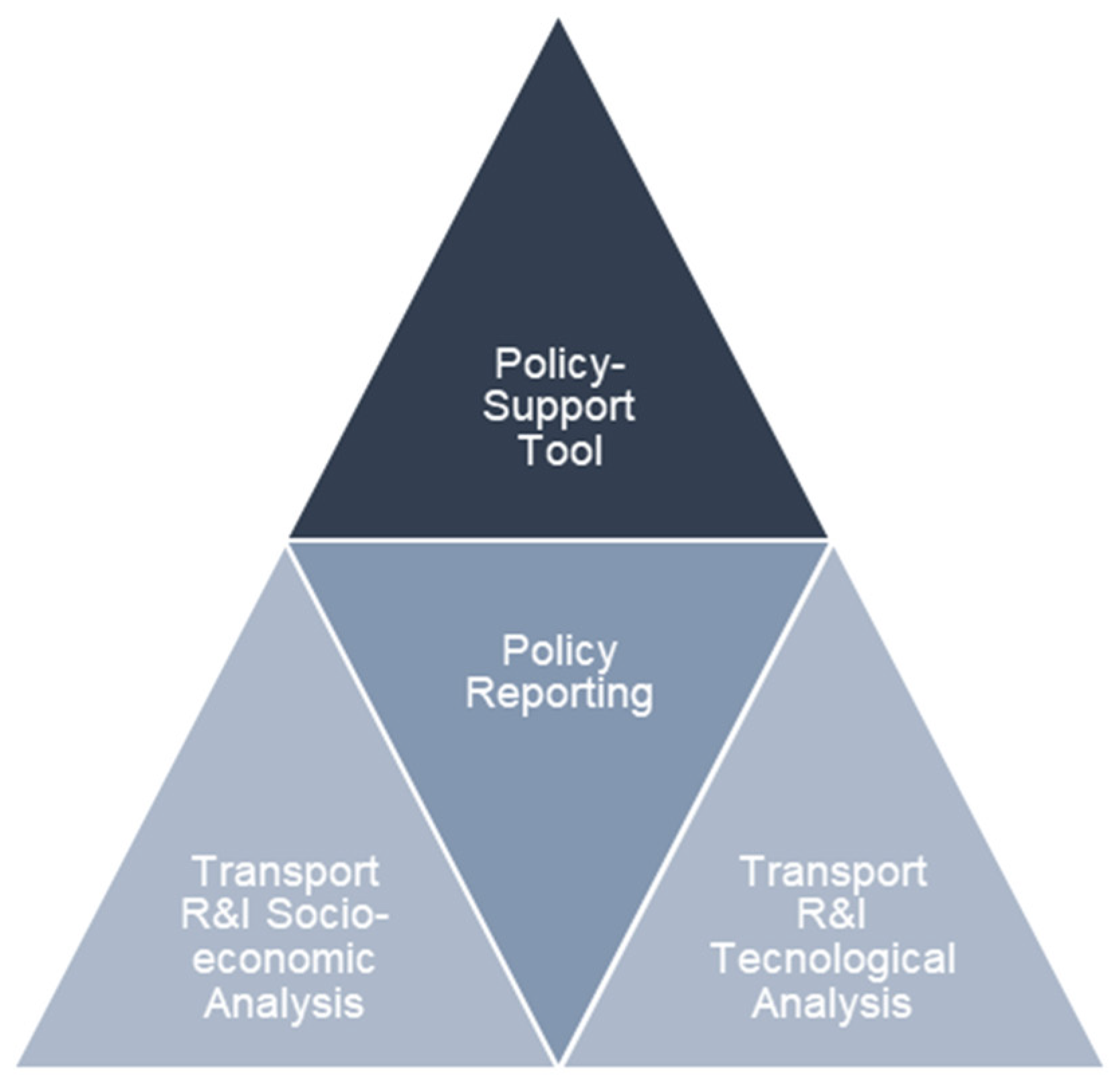
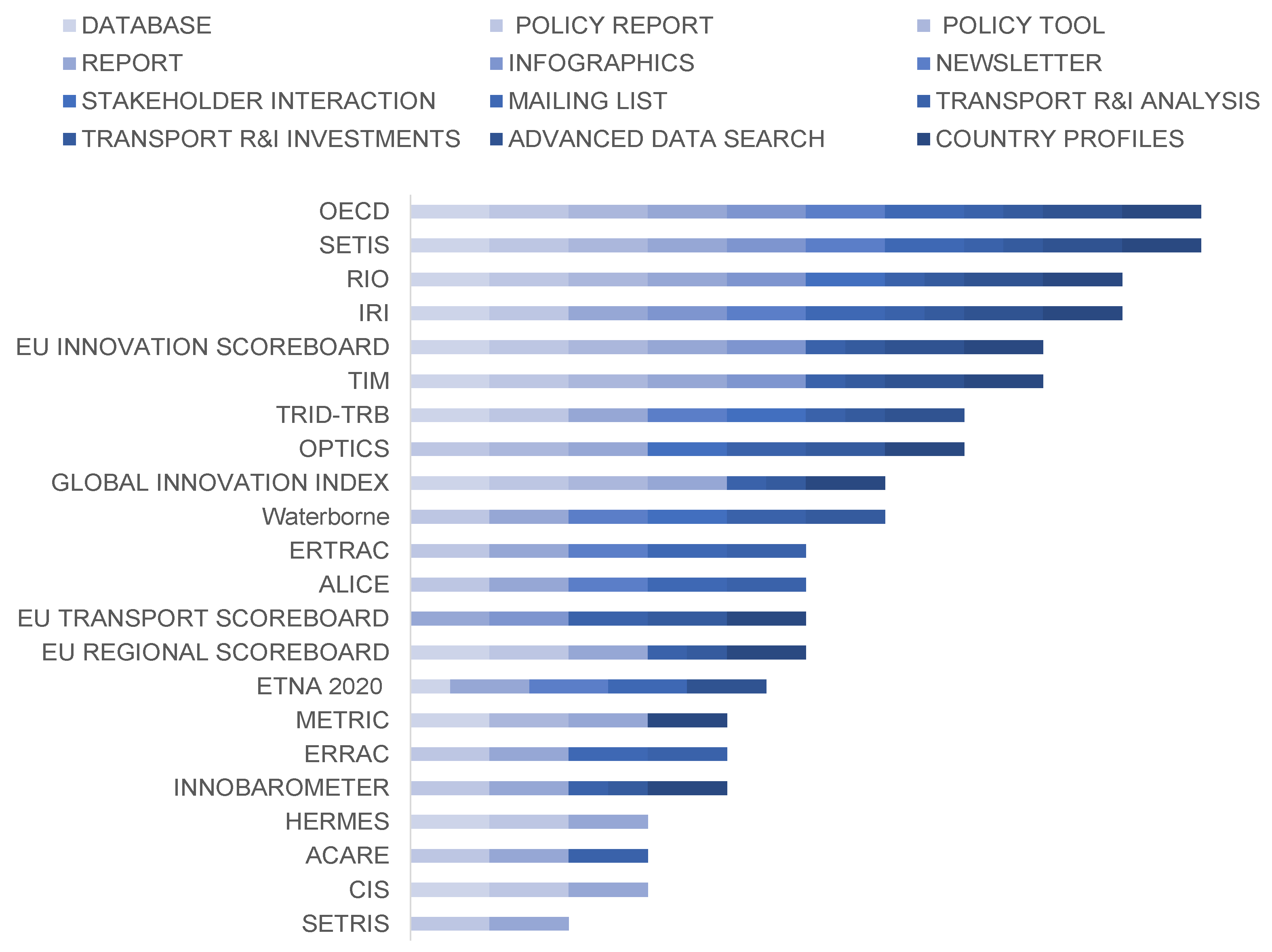

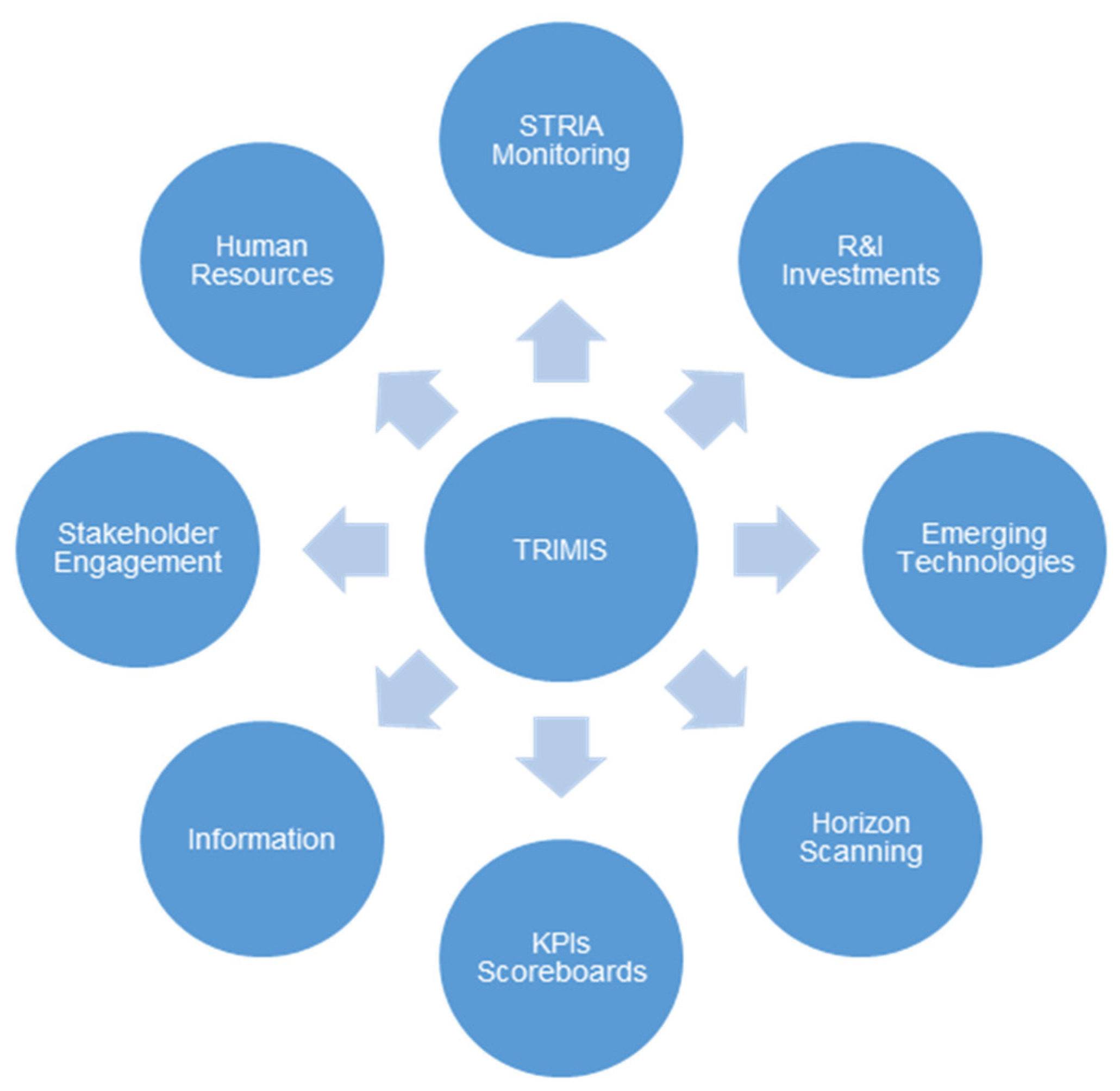
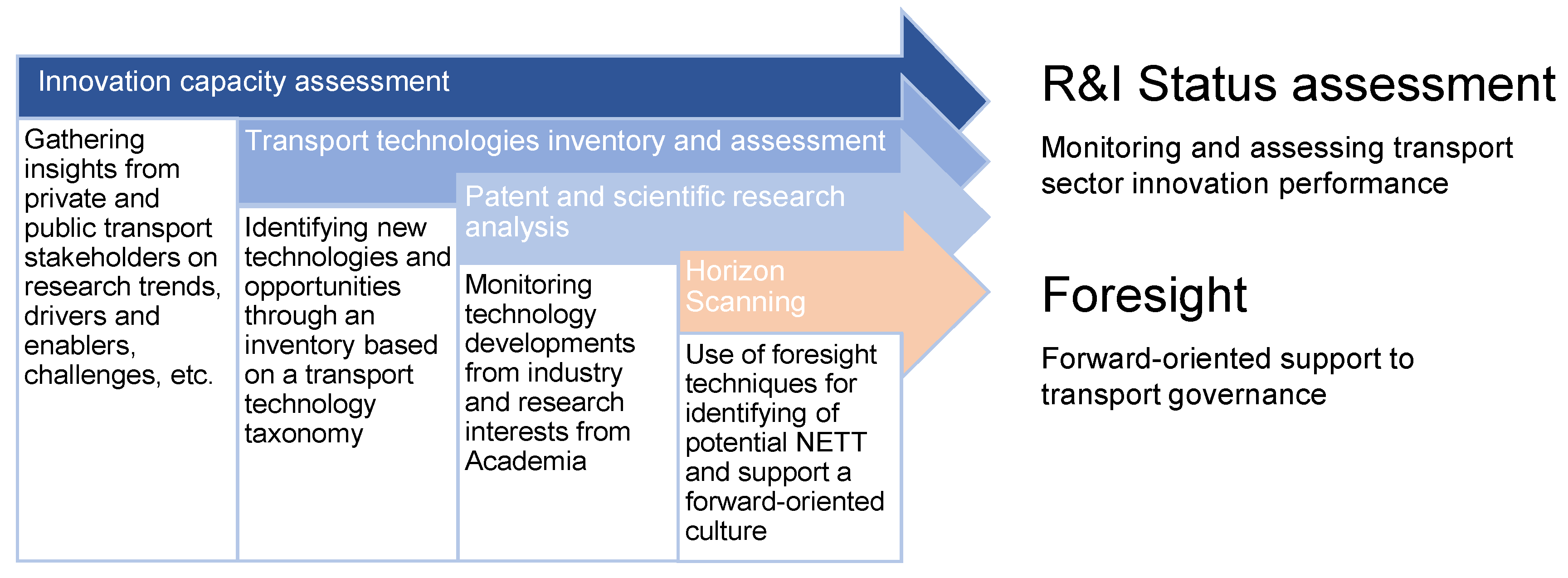
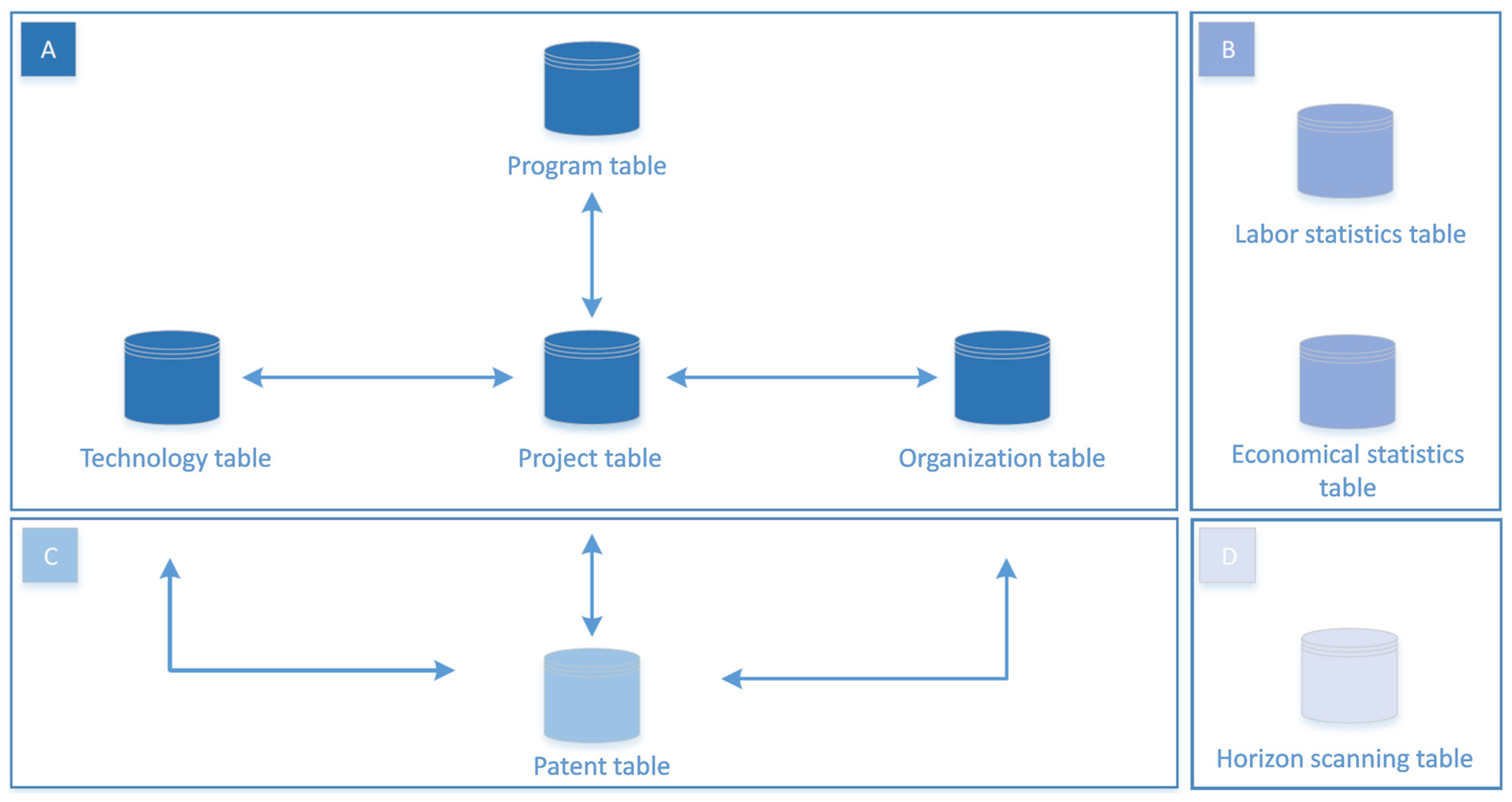

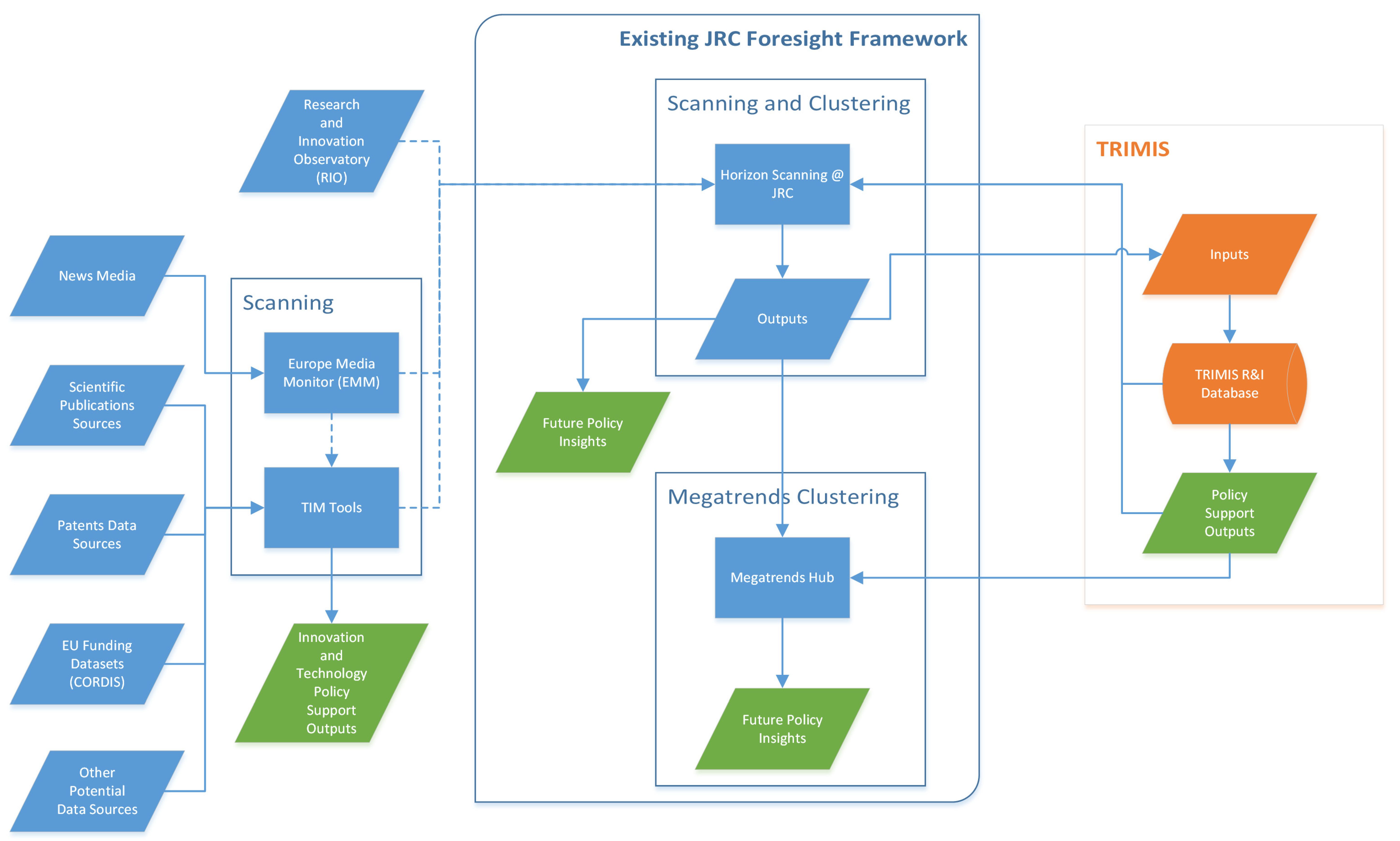
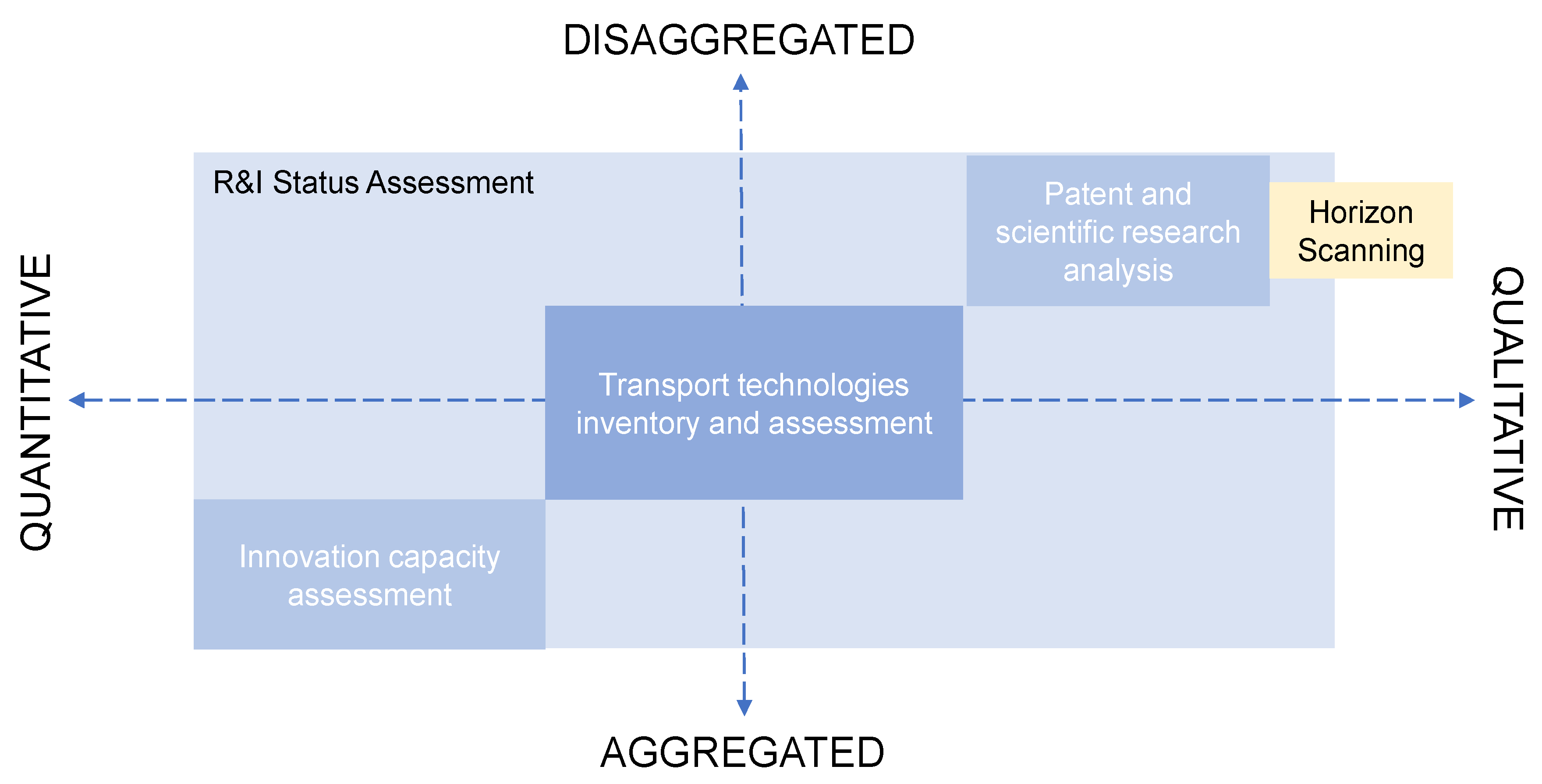
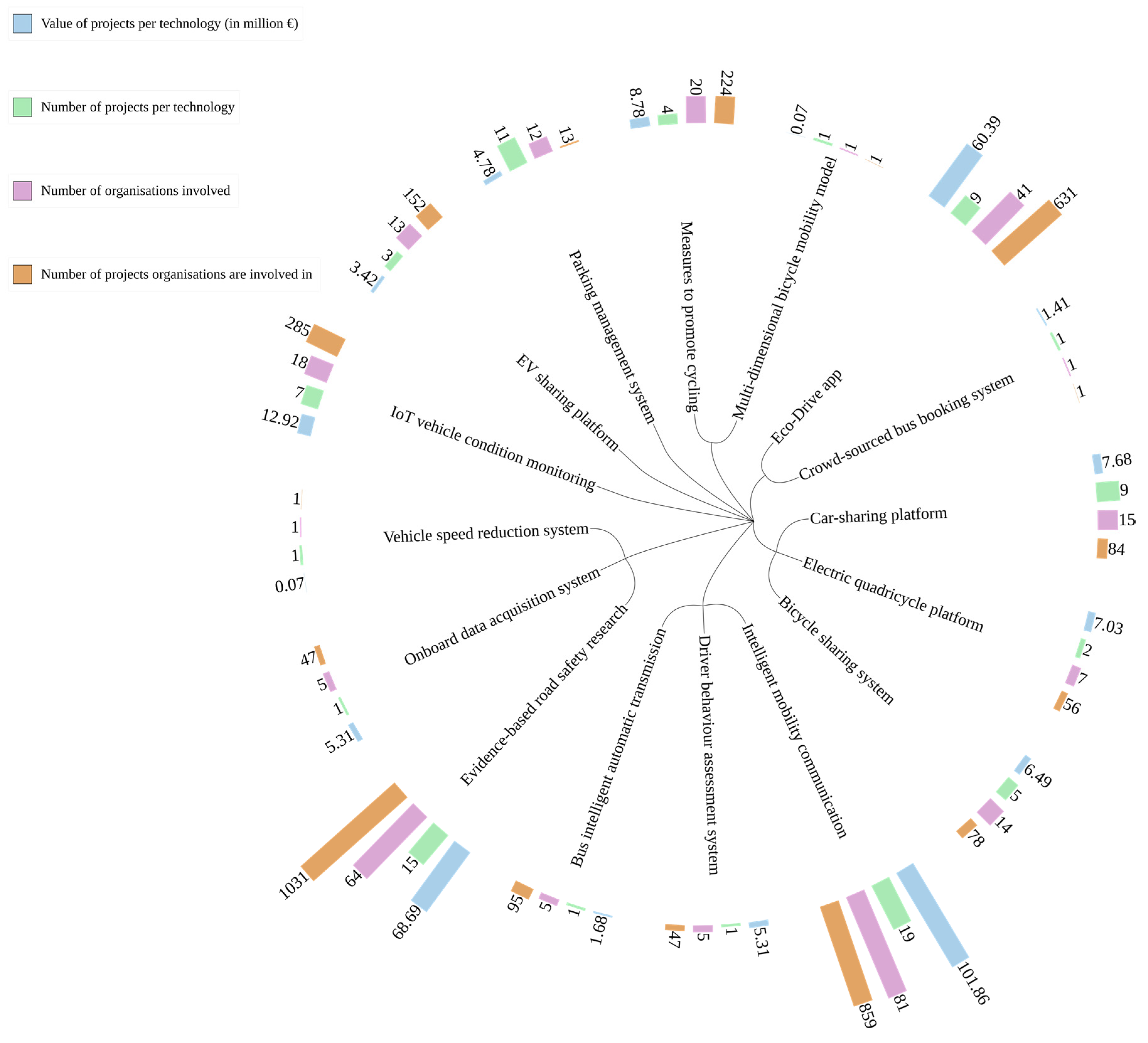
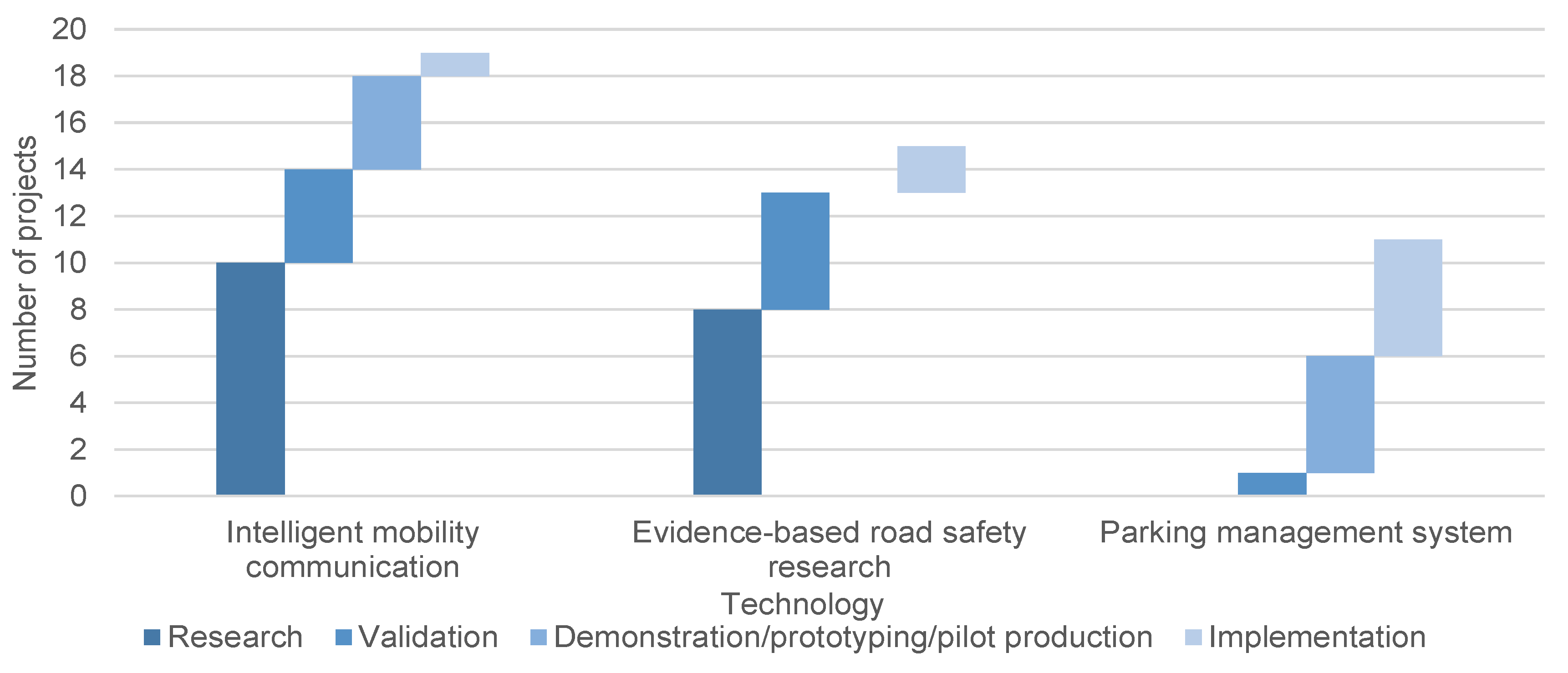
| Area of Indicator | Indicator | Description |
|---|---|---|
| Funding | Business expenditure on R&D (BERD) | BERD represents the component of gross domestic expenditure on R&D (GERD) incurred by units belonging to the business enterprise sector. It is the measure of intramural R&D expenditures within the business enterprise sector during a specific reference period. |
| Funding | Business R&D Intensity | Total business R&D spending as percentage of gross domestic product (GDP) |
| Funding | Total Government Budget Appropriations or Outlays for Research and Development (GBAORD) | The GBAORD measures the government support for research and development activities. GBAORD includes all appropriations given to R&D in central government budgets. |
| Funding | Total GBAORD as a % of total general government expenditure | Percentage of government expenditure |
| Human resources | Total R&D personnel in business enterprise | Total number of persons employed in research in a specific sector |
| Human resources | Total R&D researchers in business enterprise | Total number of researchers employed in a specific sector |
| Innovation engagement | Patent applications to the European Patent Office (EPO) | Patent applications filed directly under the European Patent Convention or applications filed under the Patent Co-operation Treaty and designated for the EPO |
| TRL | Description | TRIMIS Development Phase |
|---|---|---|
| 1 | Basic principles observed | Research |
| 2 | Technology concept formulated | |
| 3 | Experimental proof of concept | Validation |
| 4 | Technology validated in lab | |
| 5 | Technology validated in relevant environment | Demonstration/prototyping/pilot production |
| 6 | Technology demonstrated in relevant environment | |
| 7 | System prototype demonstration in operational environment | |
| 8 | System complete and qualified | Implementation |
| 9 | Actual system proven in operational environment |
| STRIA Roadmaps | ||||||||||||||
|---|---|---|---|---|---|---|---|---|---|---|---|---|---|---|
| CAT | ALT | ELT | VDM | NTM | SMO | INF | ||||||||
| Time Horizon | Long Term >10 years | OBS_K | MC_19 | CL_C | CL_A | |||||||||
| MC_23 | MC_9 | CL_B | MC_3 | |||||||||||
| Medium Term 5–10 years | CL_J | MC_17 | MC_15 | CL_F | CL_D | |||||||||
| CL_L | CL_G | MC_7 | ||||||||||||
| Short Term <5 years | CL_M | MC_18 | CL_I | MC_13 | CL_H | MC_8 | MC_1 | |||||||
| OBS_E | ||||||||||||||
Publisher’s Note: MDPI stays neutral with regard to jurisdictional claims in published maps and institutional affiliations. |
© 2020 by the authors. Licensee MDPI, Basel, Switzerland. This article is an open access article distributed under the terms and conditions of the Creative Commons Attribution (CC BY) license (http://creativecommons.org/licenses/by/4.0/).
Share and Cite
Tsakalidis, A.; Gkoumas, K.; Grosso, M.; Pekár, F. TRIMIS: Modular Development of an Integrated Policy-Support Tool for Forward-Oriented Transport Research and Innovation Analysis. Sustainability 2020, 12, 10194. https://doi.org/10.3390/su122310194
Tsakalidis A, Gkoumas K, Grosso M, Pekár F. TRIMIS: Modular Development of an Integrated Policy-Support Tool for Forward-Oriented Transport Research and Innovation Analysis. Sustainability. 2020; 12(23):10194. https://doi.org/10.3390/su122310194
Chicago/Turabian StyleTsakalidis, Anastasios, Konstantinos Gkoumas, Monica Grosso, and Ferenc Pekár. 2020. "TRIMIS: Modular Development of an Integrated Policy-Support Tool for Forward-Oriented Transport Research and Innovation Analysis" Sustainability 12, no. 23: 10194. https://doi.org/10.3390/su122310194
APA StyleTsakalidis, A., Gkoumas, K., Grosso, M., & Pekár, F. (2020). TRIMIS: Modular Development of an Integrated Policy-Support Tool for Forward-Oriented Transport Research and Innovation Analysis. Sustainability, 12(23), 10194. https://doi.org/10.3390/su122310194






